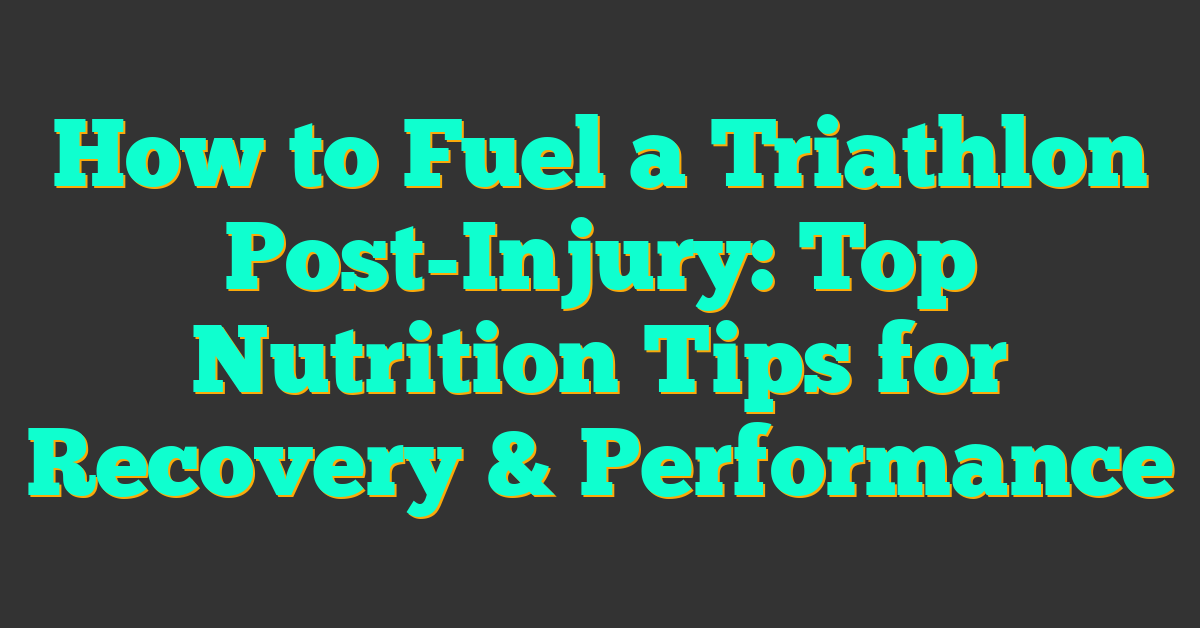Bouncing back from an injury is tough, especially when you’re gearing up for a triathlon. I know firsthand how frustrating it can be to watch your training come to a halt, but fueling your body right can make all the difference in your recovery and performance.

Nourishing yourself properly post-injury not only accelerates healing but also sets you up to tackle the pavement, water, and bike with renewed energy. In this article, I’ll share the best strategies and nutritional tips to help you get back on track and conquer that triathlon with confidence.
Importance Of Nutrition Post-Injury
- Protein: Supports muscle repair with sources like lean meats and legumes.
- Vitamins and Minerals: Facilitate tissue healing, including vitamin C from citrus fruits and calcium from dairy products.
- Carbohydrates and Fats: Maintain energy levels during rehabilitation, such as whole grains and healthy oils.
- Hydration: Ensures effective nutrient transport and cellular function by drinking water and electrolyte-rich beverages.
- Antioxidants: Reduce inflammation and oxidative stress with sources like berries and leafy greens.
Assessing Your Nutritional Needs
Understanding my nutritional requirements is essential for effective recovery and optimal triathlon performance. By tailoring my diet, I support healing and prepare my body for intense training.
Macronutrients For Recovery
- Proteins: Crucial for muscle repair and growth. I include lean meats, fish, eggs, and legumes in my meals to ensure adequate protein intake.
- Carbohydrates: Supply energy for training and replenish glycogen stores. I choose complex carbs like whole grains, fruits, and vegetables to maintain steady energy levels.
- Fats: Aid in hormone production and reduce inflammation. I incorporate healthy fats from sources such as avocados, nuts, and olive oil to support overall health.
Micronutrients Vital For Healing
- Vitamins: Vitamin C supports collagen formation, and Vitamin D enhances bone health. I consume citrus fruits, berries, leafy greens, and fortified foods to meet my vitamin needs.
- Minerals: Calcium and magnesium are key for bone strength and muscle function. I include dairy products, leafy vegetables, and nuts in my diet to maintain mineral balance.
- Antioxidants: Help reduce oxidative stress and inflammation. I add foods like berries, dark chocolate, and green tea to my daily intake to boost antioxidant levels.
Creating A Balanced Meal Plan
Developing a balanced meal plan supports my recovery and enhances my triathlon performance. I focus on including essential nutrients to rebuild strength and maintain energy.
Incorporating Protein For Muscle Repair
Protein plays a critical role in repairing muscle tissue. I include sources like lean chicken breast, turkey, tofu, and legumes in my meals. Consuming 1.2 to 1.6 grams of protein per kilogram of body weight aids effective muscle recovery. Additionally, I add protein-rich snacks such as Greek yogurt and cottage cheese to meet my daily requirements.
Carbohydrates For Energy Replenishment
Carbohydrates provide the necessary energy for training and recovery. I prioritize complex carbs like quinoa, brown rice, sweet potatoes, and whole-grain bread. These foods help replenish glycogen stores efficiently. Including a variety of fruits, such as bananas and berries, also supplies quick energy and essential vitamins.
Hydration And Its Role In Recovery
Staying hydrated is crucial for healing after an injury. Proper hydration supports nutrient transport, ensuring that vitamins and minerals reach damaged tissues efficiently. Water aids in digestion, helping your body absorb the nutrients needed for recovery. It also regulates body temperature, preventing overheating during training sessions.
Electrolytes play a significant role in maintaining fluid balance. Replenishing electrolytes like sodium, potassium, and magnesium helps prevent muscle cramps and supports nerve function. Incorporating electrolyte-rich drinks or foods, such as bananas and leafy greens, can enhance your hydration strategy.
Dehydration can slow down the healing process by reducing blood flow and oxygen delivery to injured areas. To optimize recovery, aim to drink at least 8 cups (64 ounces) of water daily, adjusting based on your training intensity and environmental conditions. Monitoring your urine color is an easy way to gauge hydration levels; a light yellow indicates adequate hydration.
| Hydration Guidelines | Details |
|---|---|
| Daily Water Intake | Minimum 64 ounces |
| Electrolyte Sources | Bananas, leafy greens, nuts |
| Signs of Adequate Hydration | Light yellow urine |
| Adjustments for Training | Increase intake as needed |
Incorporating these hydration practices into your routine will support your recovery and prepare your body for the demands of triathlon training.
Supplements To Enhance Recovery And Performance
- Protein Supplements
Aid muscle repair and growth post-training. Examples include whey protein and plant-based options like pea protein.
- Branched-Chain Amino Acids (BCAAs)
Reduce muscle soreness and speed up recovery, supporting consistent training schedules.
- Omega-3 Fatty Acids
Decrease inflammation and promote joint health. Sources include fish oil and flaxseed oil.
- Vitamin D
Supports bone health and immune function, crucial for overall recovery and injury prevention.
- Magnesium
Prevents muscle cramps and aids energy production, maintaining training performance.
- Creatine
Enhances energy production during high-intensity efforts, improving strength and endurance.
Adjusting Nutrition With Training Load
As my training load changes during recovery, I adjust my nutrition to meet my body’s evolving needs. On days with higher training intensity or longer sessions, I increase my caloric intake to provide the necessary energy for performance and recovery. Typically, I add an extra 300 calories on tough training days, focusing on carbohydrates to replenish glycogen stores.
I modify my macronutrient distribution based on training demands:
- Carbohydrates: I boost my intake by 15%, choosing sources like oatmeal, bananas, and whole grain pasta to sustain energy levels.
- Protein: Maintaining muscle repair, I aim for 1.2 grams per kilogram of body weight, incorporating lean meats, eggs, and legumes.
- Fats: I keep fats steady, emphasizing healthy options such as avocados, nuts, and olive oil to support hormone production and reduce inflammation.
To illustrate these adjustments, here’s a table outlining my macronutrient changes based on training load:
| Training Load | Calories | Carbohydrates | Protein | Fats |
|---|---|---|---|---|
| Low Intensity Days | 2,000 | 50% | 25% | 25% |
| Moderate Days | 2,300 | 55% | 25% | 20% |
| High Intensity Days | 2,500 | 60% | 20% | 20% |
« How to Choose a Triathlon Helmet: Essential Tips for Performance & Safety
Essential Triathlon Gear for Wet Conditions: Stay Dry & Boost Performance »
Hydration needs also fluctuate with training intensity. On high-load days, I increase my water intake by 16 ounces and include electrolyte-rich beverages to maintain fluid balance and prevent cramps. Monitoring my body’s responses allows me to fine-tune these nutritional strategies, ensuring optimal performance and effective recovery throughout my triathlon training.
Conclusion
Recovering from an injury while gearing up for a triathlon can be tough but with the right nutrition it’s entirely possible to bounce back stronger. I’ve seen firsthand how proper fueling can make all the difference in healing and performance. Trusting in your meal plan and staying consistent with your hydration will set you up for success. Remember to listen to your body and adjust your intake as you progress. Here’s to your recovery and smashing those triathlon goals!










